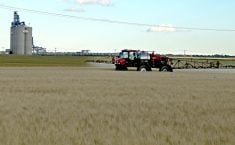The Saskatchewan Canola Development Commission and the Saskatchewan government have released a new clubroot map showing distribution of the disease throughout the province.
An updated map is released each year in mid-January.
Visible symptoms of the disease were confirmed in five additional Saskatchewan fields in 2021, bringing the total number of commercial canola fields showing visible symptoms to 80 since 2017.
The number of fields where the clubroot pathogen was detected in soil samples but where no visible symptoms of the disease were evident also increased by nine in 2021, bringing the total number of infected fields with no visible symptoms to 38 in the province.
Saskatchewan’s infection rate is increasing but is still low compared to levels in other prairie provinces.
Ongoing monitoring through an annual clubroot survey along with the continuation of a voluntary soil sampling program funded by SaskCanola have helped to slow the spread of the disease in the province, industry observers said.
More than 750 fields in 200 Saskatchewan municipalities were examined during the 2021 clubroot survey.
The landowners of all fields with visible clubroot symptoms or fields with the presence of the pathogen DNA have been contacted.
The locations of infected fields are shared with rural municipalities where the pathogen is present, but land locations of affected fields are not shared publicly.
“The Ministry of Agriculture is dedicated to early detection, tracking and managing clubroot,” said David Marit, the province’s agriculture minister, in a Jan. 10 news release.
“This protects our producers, landowners and our strong canola market.”
Last year, the ministry and SaskCanola encouraged producers to voluntarily test their fields for the presence of the clubroot pathogen.
Test kits were supplied free of charge to producers and agrologists.
Free soil testing kits will be made available again in 2022 and can be acquired through the ministry’s website. Test kits can also be requested from staff at regional Saskatchewan Agriculture offices, from SaskCanola, or through participating rural municipality offices and Saskatchewan Association of Rural Municipalities plant health officers.
A total of 100 soil samples were submitted through the voluntary soil testing program in 2021. Only one sample produced a positive result.

SaskCanola covers the full cost of soil tests using producer check-off funding.
Another eight positive soil samples were identified in 2021 through the provincial clubroot risk-based and general canola diseases surveys.
“Ongoing clubroot surveying in Saskatchewan is critical for early detection and diligent management,” said Bernie McClean, chair of SaskCanola’s board of directors.
“We continue to invest levy dollars into the provincial clubroot survey program to help farmers manage this disease with evidence and data.”
SaskCanola and the province are encouraging canola producers to adopt a proactive and science-based clubroot management strategy.
That strategy should include the use of clubroot-resistant canola varieties on all canola fields, as well as strict adherence to a minimum one-in-three-year canola rotation.


















